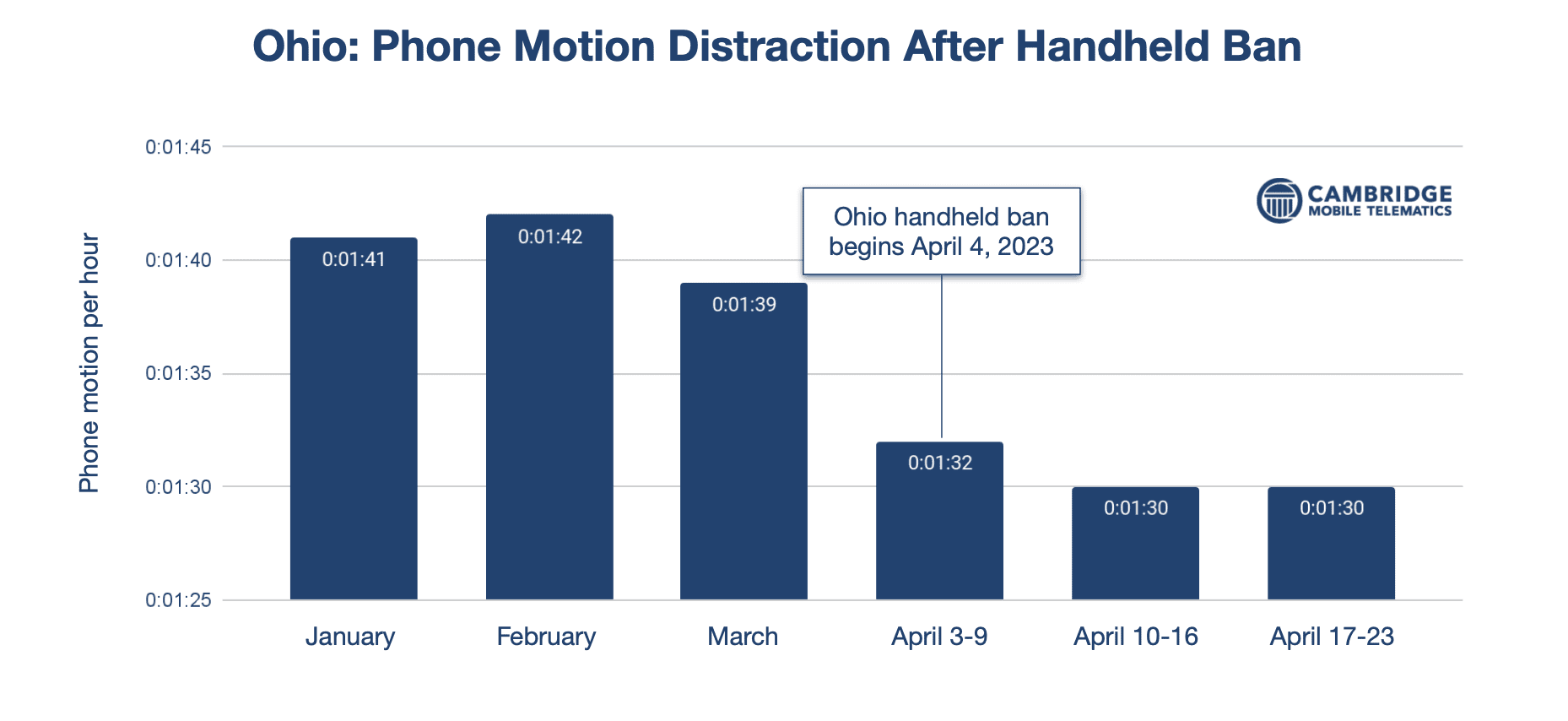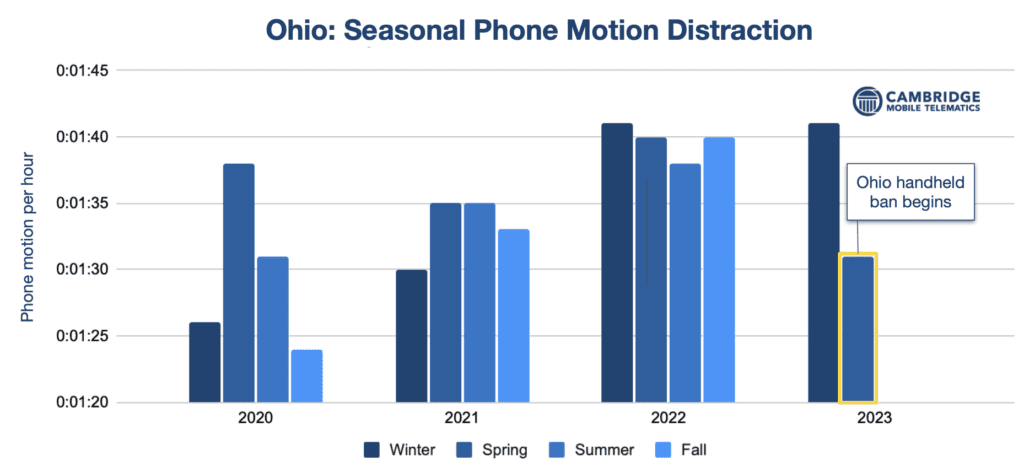Ohio Handheld Ban Has Reduced Distracted Driving by Over 8%
New data from Cambridge Mobile Telematics reveals a significant drop in phone motion distraction since April 4, 2023 in the Buckeye State

Cambridge, MA, April 25, 2023 — Cambridge Mobile Telematics (CMT), the world’s largest telematics service provider, today announced a new analysis on the distracted driving levels in Ohio, just three weeks after the state enacted a handheld phone ban. The analysis shows that Ohio drivers spent an average of 1 minute and 39 seconds per hour on the road handling their phones in March. Since the handheld ban began on April 4, phone motion distraction has fallen to an average of 1 minute and 31 seconds per hour, a drop of over 8%.
CMT’s data shows that every 10% decrease in distracted driving reduces the crash rate by 1.4%. CMT estimates that the 8% reduction in distraction in Ohio since April 4 has helped prevent over 300 crashes, one fatality, and $8 million in economic damages.*
“In CMT’s research across states analyzing the impact of handheld bans since 2018, we know that they work in the short term and they are critically important. The challenge is maintaining the gains states make after the bans go into effect,” said Ryan McMahon, SVP of Strategy for CMT. “We’re excited to be able to share these results just three weeks after Ohio’s ban went into effect and provide feedback to the road safety community. Telematics is the only way to measure these changes in driving behavior at scale in real time.”
CMT has measured the impact of hands-free legislation across eight other states since 2018. On average, states have seen a 16% reduction in phone motion distraction in the week following the law’s implementation compared to the month before. This impact fades to 13% after three months. However, by the end of 2022, the phone motion rate across the eight states was 3% higher compared to the month before the law.
CMT defines phone motion distraction as when the phone is rotating with the screen on while the vehicle is moving. Auto insurers use phone motion in usage-based insurance pricing to assess risk, and can impact a driver’s premium.
Phone motion distraction has increased consistently in Ohio since 2020. In 2020, drivers spent an average of 1 minute and 30 seconds per hour handling their phones while driving. In 2021, that number increased to 1 minute and 34 seconds. By 2022, phone motion distraction reached 1 minute and 40 seconds, an 11% increase compared to 2020. From January through March 2023, the average was 1 minute and 41 seconds.

There has been no consistent pattern in seasonal phone motion levels in Ohio since 2020. In 2020, phone motion surged by 14% in the spring, when the WHO declared Covid-19 a global pandemic. In 2021, the spring and summer seasons saw the highest levels of phone motion distraction, with an average of 1 minute and 35 seconds per hour. In 2022, winter was the highest season, with 1 minute and 41 seconds per hour. The current 8% drop in phone motion distraction in Ohio is the biggest the state has seen since 2020.
For more insights about distracted driving across the United States since 2020, see CMT’s 2023 distracted driving report: The State of Distracted Driving in 2023 & the Future of Road Safety.
About Cambridge Mobile Telematics
Cambridge Mobile Telematics (CMT) is the world’s largest telematics service provider. Its mission is to make the world’s roads and drivers safer. The company’s AI-driven platform, DriveWell®, gathers sensor data from millions of IoT devices — including smartphones, proprietary Tags, connected vehicles, dashcams, and third-party devices — and fuses them with contextual data to create a unified view of vehicle and driver behavior. Companies from personal and commercial auto insurance, automotive, rideshare, smart cities, wireless, financial services, and family safety industries use insights from CMT’s platform to power their risk assessment, safety, claims, and driver improvement programs. Headquartered in Cambridge, MA, with offices in Budapest, Chennai, Seattle, Tokyo, and Zagreb, CMT serves millions of people through over 95 programs in 25 countries, including 21 of the top 25 US auto insurers. Learn more at CMT.ai.
*Estimates based on the change in crash rate from distracted driving and data from NHTSA’s report The Economic and Societal Impact of Motor Vehicle Crashes, 2019: $340 billion in crash damages from 14.2 million crashes in 2019, averaging $23,954 per crash